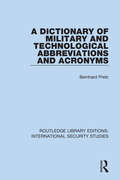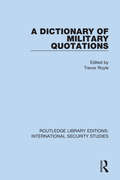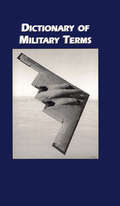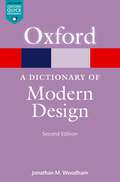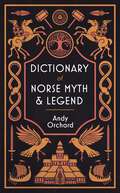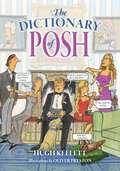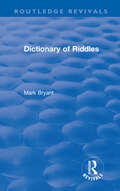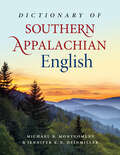- Table View
- List View
Dictionary of Labour Biography: Volume XV
by David Howell Keith GildartThe Dictionary of Labour Biography has an outstanding reputation as a reference work for the study of nineteenth and twentieth century British history. Volume XV maintains this standard of original and thorough scholarship. Each entry is written by a specialist drawing on an array of primary and secondary sources. The biographical essays engage with recent historiographical developments in the field of labour history. The scope of the volume emphasises the ethnic and national diversity of the British labour movement and neglected political traditions.
A Dictionary of Liverpool Ship Portraitists and Marine Artists
by Anthony TibblesThis dictionary is the most comprehensive work of reference on the ship portraitists and marine artists who worked in Liverpool between the late eighteenth century and the present day. It includes 65 known portraitists and marine artists and an appendix of over a dozen other locally-based painters who produced an occasional marine work and about half a dozen possible marine artists who may have worked, visited or have been temporarily resident in the port. It is organised alphabetically by surname. Each entry includes a full biography of the artist; a summary of their main subjects, style and range of work; details of the main UK and US museums holding their paintings; and the principal published sources. The dictionary includes 70 illustrations which are typical examples of the work of each of the main artists. These included: Samuel and Miles Walters, Joseph Heard, Robert Salmon, Francis Hustwick, William Jackson, John Jenkinson, Sam Brown, Odin Rosenvinge, Thomas Dove, William G Yorke and William H Yorke.
The Dictionary of Lost Words: A REESE WITHERSPOON BOOK CLUB PICK
by Pip Williams'An enchanting story about love, loss and the power of language' Elizabeth Macneal, author of The Doll FactorySometimes you have to start with what's lost to truly find yourself...Motherless and irrepressibly curious, Esme spends her childhood at her father's feet as he and his team gather words for the very first Oxford English Dictionary.One day, she sees a slip of paper containing a forgotten word flutter to the floor unclaimed.And so Esme begins to collect words for another dictionary in secret: The Dictionary of Lost Words. But to do so she must journey into a world on the cusp of change as the Great War looms and women fight for the vote. Can the power of lost words from the past finally help her make sense of her future?'A brilliant book about women and words - tender, moving and profound' Jacqueline WilsonReaders LOVE The Dictionary of Lost Words:'If you only read one book this year, let it be this one!''If you're a fan of The Binding and The Betrayals you will surely love this''A glorious combination of words, growing up, friendship, love, feminism and so much more''The best love letter to words and language''This book broke my heart ... I highly recommend it to any historical fiction fans ... it's one I will be reading again'
Dictionary of Medical Vocabulary in English, 1375–1550: Body Parts, Sicknesses, Instruments, and Medicinal Preparations
by Juhani NorriMedical texts written in English during the late Middle Ages have in recent years attracted increasing attention among scholars. From approximately 1375 onwards, the use of English began to gain a firmer foothold in medical manuscripts, which in previous centuries had been written mainly in Latin or French. Scholars of Middle English, and editors of medical texts from late medieval England, are thus faced with a huge medical vocabulary which no single volume has yet attempted to define. This dictionary is therefore an essential reference tool. The material analysed in the Dictionary of Medical Vocabulary in English, 1375–1550 includes edited texts, manuscripts and early printed books, and represents three main types of medical writing: surgical manuals and tracts; academic treatises by university-trained physicians, and remedybooks. The dictionary covers four lexical fields: names of sicknesses, body parts, instruments, and medicinal preparations. Entries are structured as follows: (1) headword (2) scribal variants occurring in the texts (3) etymology (4) definition(s), each definition followed by relevant quotations (5) references to corresponding entries in the Dictionary of Old English, Middle English Dictionary, and The Oxford English Dictionary (6) references to academic books and articles containing information on the history and/or meaning of the term.
Dictionary of Medical Vocabulary in English, 1375–1550: Body Parts, Sicknesses, Instruments, and Medicinal Preparations
by Juhani NorriMedical texts written in English during the late Middle Ages have in recent years attracted increasing attention among scholars. From approximately 1375 onwards, the use of English began to gain a firmer foothold in medical manuscripts, which in previous centuries had been written mainly in Latin or French. Scholars of Middle English, and editors of medical texts from late medieval England, are thus faced with a huge medical vocabulary which no single volume has yet attempted to define. This dictionary is therefore an essential reference tool. The material analysed in the Dictionary of Medical Vocabulary in English, 1375–1550 includes edited texts, manuscripts and early printed books, and represents three main types of medical writing: surgical manuals and tracts; academic treatises by university-trained physicians, and remedybooks. The dictionary covers four lexical fields: names of sicknesses, body parts, instruments, and medicinal preparations. Entries are structured as follows: (1) headword (2) scribal variants occurring in the texts (3) etymology (4) definition(s), each definition followed by relevant quotations (5) references to corresponding entries in the Dictionary of Old English, Middle English Dictionary, and The Oxford English Dictionary (6) references to academic books and articles containing information on the history and/or meaning of the term.
Dictionary of Mexican Rulers, 1325-1997
by Juana Vazquez-GomezThis user-friendly reference dictionary provides a quick guide to those who have governed Mexico from 1325 to 1997. It covers all rulers from the Aztec Empire to the current president, Ernesto Zedillo. The book provides an objective portrait of the political leadership and describes the circumstances surrounding major events. Arranged chronologically, with a glossary, appendixes, and name index, the book includes four main chapters—The Aztec Empire, The Conquest and Viceroyalty, From Independence to the DÍaz Dictatorship, and Revolution and Modern Mexico. Each chapter opens with a brief characterization of the period.A practical guide to Mexico's long and complicated history, this book contains short biographical entries on each of the country's 185 rulers. Entries describe the main accomplishments and failures of each tenure. The book also includes an appendix describing Mexico's main plans, treaties, conspiracies, and constitutions.
A Dictionary of Military and Technological Abbreviations and Acronyms (Routledge Library Editions: International Security Studies #3)
by Bernhard PretzThis book, first published in 1983, is a compilation of some 50,000 acronyms and abbreviations used by the British, American, German and Soviet military. It enables the researcher to understand the language of the Armed Forces, their armaments and the related technology, and to reach a greater understanding of the capabilities and duties of the Armed Forces at the end of the Cold War. The Dictionary covers all the services and their technology, and is an indispensable reference work.
A Dictionary of Military and Technological Abbreviations and Acronyms (Routledge Library Editions: International Security Studies #3)
by Bernhard PretzThis book, first published in 1983, is a compilation of some 50,000 acronyms and abbreviations used by the British, American, German and Soviet military. It enables the researcher to understand the language of the Armed Forces, their armaments and the related technology, and to reach a greater understanding of the capabilities and duties of the Armed Forces at the end of the Cold War. The Dictionary covers all the services and their technology, and is an indispensable reference work.
A Dictionary of Military Quotations (Routledge Library Editions: International Security Studies #4)
by Trevor RoyleThis book, first published in 1990, is a provocative collection of military quotations that captures the human essence of warfare. From the skirmishes beneath the walls of Troy to the dropping of the atomic bomb, nearly 3,500 quotations distil the experiences of generations of soldiers, depicting the preparation for and the waging of war. Read the words of field marshals and generals, kings and dictators, and follow them into battle – Alexander the Great at Issus, Wellington at Waterloo, Sitting Bull at Little Big Horn and Montgomery at El Alamein. Here too are the recorded details of life among the ranks as diverse as ammunition and uniform, sick parade and comradeship, discipline and ‘Dear John’ letters. A final section, ‘Last Post’, deals with the tragic aftermath of conflict.
A Dictionary of Military Quotations (Routledge Library Editions: International Security Studies #4)
by Trevor RoyleThis book, first published in 1990, is a provocative collection of military quotations that captures the human essence of warfare. From the skirmishes beneath the walls of Troy to the dropping of the atomic bomb, nearly 3,500 quotations distil the experiences of generations of soldiers, depicting the preparation for and the waging of war. Read the words of field marshals and generals, kings and dictators, and follow them into battle – Alexander the Great at Issus, Wellington at Waterloo, Sitting Bull at Little Big Horn and Montgomery at El Alamein. Here too are the recorded details of life among the ranks as diverse as ammunition and uniform, sick parade and comradeship, discipline and ‘Dear John’ letters. A final section, ‘Last Post’, deals with the tragic aftermath of conflict.
Dictionary of Military Terms
by Richard BowyerFirst Published in 2000. Routledge is an imprint of Taylor & Francis, an informa company.
Dictionary of Military Terms: Over 6,000 Words Clearly Defined (Dictionaries Ser.)
by Richard BowyerFirst Published in 2000. Routledge is an imprint of Taylor & Francis, an informa company.
Dictionary Of Modern American Philosophers
by John R. ShookThe Dictionary of Modern American Philosophers includes both academic and non-academic philosophers, and a large number of female and minority thinkers whose work has been neglected. It includes those intellectuals involved in the development of psychology, pedagogy, sociology, anthropology, education, theology, political science, and several other fields, before these disciplines came to be considered distinct from philosophy in the late nineteenth century.Each entry contains a short biography of the writer, an exposition and analysis of his or her doctrines and ideas, a bibliography of writings, and suggestions for further reading. While all the major post-Civil War philosophers are present, the most valuable feature of this dictionary is its coverage of a huge range of less well-known writers, including hundreds of presently obscure thinkers. In many cases, the Dictionary of Modern American Philosophers offers the first scholarly treatment of the life and work of certain writers. This book will be an indispensable reference work for scholars working on almost any aspect of modern American thought.
Dictionary Of Modern Art
by Matthew BaigellAlphabetically arranged and crossreferenced entries provide background information on major American painters, sculptors, printmakers, and photographers, plus important topics and movements central to American art from the sixteenth century to the present.
Dictionary Of Modern Art
by Matthew BaigellAlphabetically arranged and crossreferenced entries provide background information on major American painters, sculptors, printmakers, and photographers, plus important topics and movements central to American art from the sixteenth century to the present.
A Dictionary of Modern Design (Oxford Quick Reference Online)
by Jonathan WoodhamOver 950 entries From the Arts and Crafts Movement to Postmodernism, Apple to Frank Lloyd Wright, this fascinating dictionary covers the past 160 years of international design, with accessible entries on branding, graphics, industrial design, functionalism, and fashion. New entries on digital design and sustainable design bring the coverage up to date. The dictionary's international focus takes in major movements, key concepts, design terminology, and important design institutions, museums, and heritage sites. The new edition reflects the growing global importance of design, with coverage of India, China, the countries of the Pacific Rim, Eastern Europe and East Asia, and demonstrates how developments in the design of technology influence everyday life, with new entries on fonts, games developers such as Gunpei Yokoi of Nintendo, Android, Samsung, and Blackberry, and a fully revised entry on Apple. The A-Z entries are complemented by an extensive bibliography and a timeline.
A Dictionary of Mutual Understanding: The compelling Richard and Judy Summer Book Club winner
by Jackie CopletonLONGLISTED FOR THE BAILEYS WOMEN'S PRIZE FOR FICTION 2016A BBC RADIO 2 BOOK CLUB PICK 'Memoirs of a Geisha meets The Piano Teacher, in the best way.' InStyleAmaterasu Takahashi has spent her life grieving for her daughter Yuko and grandson Hideo, who were victims of the atomic bomb dropped on Nagasaki in 1945. Now a widow living in America, she believes that one man was responsible for her loss; a local doctor who caused an irreparable rift between mother and daughter. When a man claiming to be Hideo arrives on her doorstep, she is forced to revisit the past; the hurt and humiliation of her early life, the intoxication of a first romance and the realisation that if she had loved her daughter in a different way, she might still be alive today.
Dictionary of Norse Myth & Legend
by Andrew OrchardFrom Loki to Thor, Ragnarok to BeowulfA gripping and truly mesmerising delve into the Norse legendsFrom bestselling books to blockbusting Hollywood movies, the myths of the Scandinavian gods and heroes are part of the modern day landscape.For over a millennium before the arrival of Christianity, the legends permeated everyday life in Iceland and the northern reaches of Europe. Since that time, they have been perpetuated in literature and the arts in forms as diverse as Tolkien and Wagner, graphic novels to the world of Marvel. This book covers the entire cast of supernatural beings, from gods to trolls, heroes to monsters, and deals with the social and historical background to the myths, topics such as burial rites, sacrificial practices and runes.
A Dictionary of Philosophy of Religion, Second Edition
by Charles Taliaferro Elsa J. MartyA Dictionary of Philosophy of Religion is an indispensable resource for students and scholars. Covering historical and contemporary figures, arguments, and terms, it offers an overview of the vital themes that make philosophy of religion the growing, vigorous field that it is today. It covers world religions and sources from east and west. Entries have been crafted for clarity, succinctness, and engagement. This second edition includes new entries, extended coverage of non-Christian topics, as well as revisions and updates throughout.The first edition was named a Choice Outstanding Academic Title of the Year.
A Dictionary of Philosophy of Religion, Second Edition
by Charles Taliaferro Elsa J. MartyA Dictionary of Philosophy of Religion is an indispensable resource for students and scholars. Covering historical and contemporary figures, arguments, and terms, it offers an overview of the vital themes that make philosophy of religion the growing, vigorous field that it is today. It covers world religions and sources from east and west. Entries have been crafted for clarity, succinctness, and engagement. This second edition includes new entries, extended coverage of non-Christian topics, as well as revisions and updates throughout.The first edition was named a Choice Outstanding Academic Title of the Year.
The Dictionary of Posh: Incorporating the Fall and Rise of the Pails-Hurtingseaux Family
by Hugh KellettThe Dictionary of Posh serves as an essential guide to the (ab)use of many English words by the decidedly up-market and the resultant — and endangered — language they speak: Posh. Hugh Kellett hilariously captures the spirit and nuances of those who speak Posh and, allied with Oliver Preston's brilliantly accurate cartoons, this book is the key to understanding and interpreting this language ?— literally with tongue-in-cheek. Hidden within normal English is a separate language still spoken by those born with silver spoons in their mouths. It's called Posh. A word of English can be spelt the same but mean something completely different in Posh. If you say the word 'Mention' in English, people will understand 'Remark upon'; but in Posh this means a large house. Say 'Ace' and speakers of Posh will think you are referring to a cold thing one's butler puts in one's G&T.
Dictionary of Riddles (Routledge Revivals)
by Mark BryantOriginally published in 1990 by Routledge, Dictionary of Riddles is a collection of nearly 1500 of the most cryptic and entertaining riddles from history. Drawn from sources throughout the world, the collection ranges from earthy medieval jokes about fleas, worms and vegetables to the sophisticated puzzles composed by literary figures from Schiller, Swift, Voltaire, Rousseau and Cervantes to Edgar Allan Poe, Lewis Carroll and J.R.R. Tolkien. The book traces the history of riddles from their origins in antiquity through the golden age of the Renaissance, to their decline into the nursery and the first few signs of their modern revival, and draws together all the strands of the riddling art. Dictionary of Riddles received a Special Commendation in Reference Review’s Best Specialist Reference Books of 1990 Awards.
Dictionary of Southern Appalachian English
by Michael B. Montgomery & Jennifer K. N. HeinmillerThe Dictionary of Southern Appalachian English is a revised and expanded edition of the Weatherford Award–winning Dictionary of Smoky Mountain English, published in 2005 and known in Appalachian studies circles as the most comprehensive reference work dedicated to Appalachian vernacular and linguistic practice. Editors Michael B. Montgomery and Jennifer K. N. Heinmiller document the variety of English used in parts of eight states, ranging from West Virginia to Georgia—an expansion of the first edition's geography, which was limited primarily to North Carolina and Tennessee—and include over 10,000 entries drawn from over 2,200 sources. The entries include approximately 35,000 citations to provide the reader with historical context, meaning, and usage. Around 1,600 of those examples are from letters written by Civil War soldiers and their family members, and another 4,000 are taken from regional oral history recordings. Decades in the making, the Dictionary of Southern Appalachian English surpasses the original by thousands of entries. There is no work of this magnitude available that so completely illustrates the rich language of the Smoky Mountains and Southern Appalachia.
Dictionary of Subjects and Symbols in Art
by James HallThe understanding and enjoyment of a work of art depends as much on the story it depicts as on the artist's execution of it. But what were once biblical or classical commonplaces are not so readily recognizable today. This book relates in a succinct and readable way the themes, sacred and secular, on which the repertoire of Western art is based. Combined here in a single volume are religious, classical, and historical themes, figures of moral allegory, and characters from romantic poetry that appeared throughout paintings and sculpture in Western art before and after the Renaissance. More than just a dictionary, this text places these subjects in their narrative, historical, or mythological context and uses extensive cross-referencing to enhance and clarify the meanings of these themes for the reader. The definitive work by which others are compared, this volume has become an indispensable handbook for students and general appreciators alike. This wholly redesigned second edition includes a new insert of images chosen by the author, as well as a new preface and index to highlight the ideas, beliefs, and social and religious customs that form the background of much of this subject matter.
Dictionary of Subjects and Symbols in Art (Icon Editions Ser.)
by James HallThe understanding and enjoyment of a work of art depends as much on the story it depicts as on the artist's execution of it. But what were once biblical or classical commonplaces are not so readily recognizable today. This book relates in a succinct and readable way the themes, sacred and secular, on which the repertoire of Western art is based. Combined here in a single volume are religious, classical, and historical themes, figures of moral allegory, and characters from romantic poetry that appeared throughout paintings and sculpture in Western art before and after the Renaissance. More than just a dictionary, this text places these subjects in their narrative, historical, or mythological context and uses extensive cross-referencing to enhance and clarify the meanings of these themes for the reader. The definitive work by which others are compared, this volume has become an indispensable handbook for students and general appreciators alike. This wholly redesigned second edition includes a new insert of images chosen by the author, as well as a new preface and index to highlight the ideas, beliefs, and social and religious customs that form the background of much of this subject matter.





